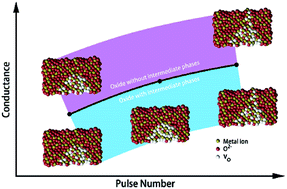Tuning analog resistive switching and plasticity in bilayer transition metal oxide based memristive synapses†
Abstract
Memristive devices with analog resistive switching characteristics are widely investigated nowadays for electronic synapses that facilitate memory and learning in neuromorphic computing hardware. It is therefore essential to understand and optimize the incremental switching behavior of the cells in order to enhance the functionality of memristive neural networks. Here we report a systematic study on the analog switching of bilayer oxide based memristive synapses and show that transition metal oxides with rich intermediate phases, such as WOx, are able to provide larger number of conductance states compared with oxides with few intermediate phases such as TaOx and HfOx. This could be attributed to the intrinsically different electrical properties of the intermediate phases that jointly contribute to the change of device conductance, in addition to that caused by the varied geometry of filaments during programming. Controlled studies adopting different materials, compositions and sequences of oxide bilayers reveal that the analog switching is mainly dominated by the switching layer, thus providing clues to the optimization of memristive devices for future neuromorphic applications.



 Please wait while we load your content...
Please wait while we load your content...